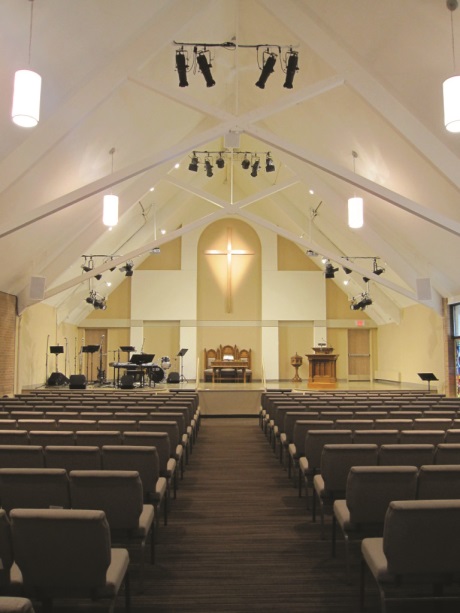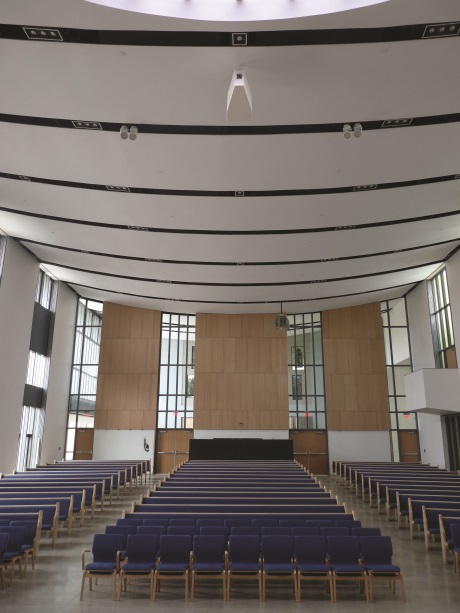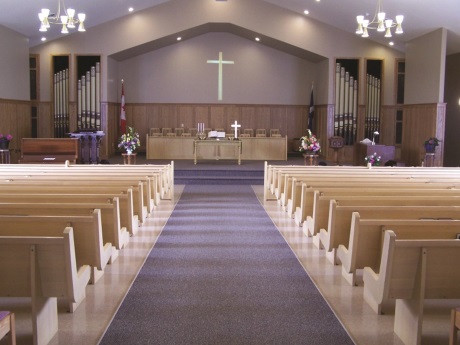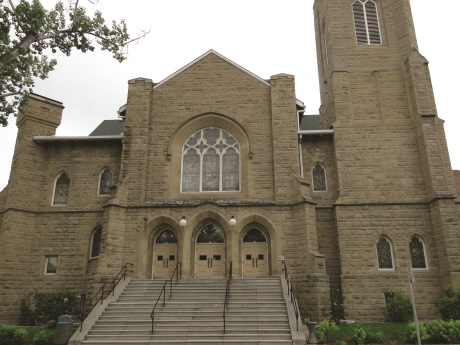Time takes its toll on a church building. In turn, an aging building can take its toll on the members. Spaces that once nurtured worship, fellowship and community involvement feel less welcoming: it’s too cold in the winter, too hot in the summer; steps up to the main doors are daunting to elderly members and visitors; persons with disabilities can only access limited areas of the building.
It’s time to rejuvenate the building—or even build anew. This will take significant funds over and above a congregation’s annual budget. But how?
Stage 1 – Reclaim Your Purpose
Chippawa, Niagara Falls, Ont., was inspired by the gospel story of four friends who so desperately want their ailing friend to encounter Jesus, they remove pieces of a roof to lower him down into a house. In the same spirit, Chippawa wanted their neighbours to encounter Jesus, even if it meant radically altering their physical space.
When Rev. Doug Schonberg came to Chippawa in 1998 it had been more than 40 years since the congregation had made any significant upgrades to their building. Over the years, barriers had piled up: “[We had] washrooms that were not handicapped accessible, a lower level that was unreachable for those who cannot manage stairs, a nursery that was in a distant basement corner, a Sunday school program that was scattered throughout the building, a foyer that could not accommodate enough people in the times around worship, offices that were difficult to find, a main entrance that was not obvious, nor easily accessible,” Schonberg explains.
Yet as they began to take a closer look at these individual barriers, the solutions kept clashing: “We realized how interconnected the problems were. What we needed was a cohesive plan—one that took into account the breadth of issues.”
To form such a plan, Chippawa’s session reviewed a comprehensive inventory of the church building’s problems compiled by the board of managers, consulted an engineer, spoke with other congregations and collected survey responses from members in the congregation.
“We developed a deep understanding of our space and how it was being used,” says Schonberg. Only then did they formally approach the congregation, seeking approval to form a strategic planning team.
Conversations with the congregation continued, helping the strategic team develop a clearer picture of what kind of design would best serve their ministry. They collaborated with an architect who came up with sketches inspired by Chippawa’s core values: transparency, accessibility, flexibility and inclusivity.
All this happened before a campaign was launched.
“I think a congregation is ready to start a campaign when they have a clear purpose; when there’s an understanding about what ministry they want to do and how the campaign opens doors for the ministry. It can’t just be about comfort or fixing up the building,” explains Schonberg.
“For us, a new building was just part of the vision,” says Rev. Brooke Ashfield, one of the pastors at Knox, Waterloo, Ont.
Like Chippawa, discussion around improving Knox’s physical space emerged naturally. One of their key epiphanies occurred at a visioning retreat. “We talked about ‘boosters and barriers’ to growth. We decided the number one barrier was our building.”
Ashfield recalls three areas in particular where the building restricted growth: a limited amount of classroom space was placing a strain on the Sunday school program; the congregation wanted to hire more staff but needed more office space; and they were experiencing crowding issues in the sanctuary during worship on Sunday mornings.
After some research they learned they had two options: do extensive renovations or build new. If they spent $3 million – plus to renovate, they would have a little more room and a facility that could last another 20 years. Building new would cost $7.5 million, but they would have significantly more space and the building would last longer.
Stage 2 – Plan a Campaign
“Do your homework” is a common refrain from church leaders. The challenge is to take the sea of information and funnel it into an even – flowing stream. The information needs to be clear, condensed and fresh, bringing more life to a vision that has already been nurtured.
Summerside, P.E.I., intended to renovate the front part of their sanctuary; but, they discovered faulty facing had caused extensive water damage. Addressing structural concerns became their focus. They didn’t want to merely patch up the problem, only to revisit it a few years later. They decided the best way forward was to rebuild. Yet when it came to raising the money to fund the project, they had trouble getting started.
Around this time, Rev. Dr. Herb Gale, associate secretary of the Presbyterian Church in Canada’s Planned Giving office, visited the congregation. The conversation ended up being more about Summerside’s building project. “Our situation had a lot of parallels with Westminster – St. Paul’s, Guelph, Ont., where Herb had been minister,” remembers Nancy Harvey, deputy clerk of session. “He helped us get unstuck. It was his suggestion and encouragement we hire a professional fundraising consultant.”
Summerside’s consultants conducted a feasibility study to gauge the level of financial support the church could expect if they decided to move forward with a building campaign.
“The consultants told us we would need so many of what they called ‘ground – breaking gifts,’ which were $15,000 or higher, so many ‘cornerstone gifts’ which were between $5,000 and $10,000, and so on. We never thought of looking at it that way—breaking it up into categories and seeking out specific amounts,” recalls Harvey. The feasibility study gave them the courage to move forward with confidence and to strategically plan their campaign.
Conversely, when Grace, Calgary, Alta., needed to renovate their old heating system, they did not hire a consultant for their campaign as they have skilled lay leaders who took on that role.
Stage 3 – Run a Successful Campaign
Chippawa’s 16 – week campaign began with eight weeks of “program preparation.”
In this period a campaign team was recruited and then trained by professional consultants. Roles within the team were defined and the team finalized all campaign resources, messaging, design and events.
This first half of the program was geared toward the core group of campaign team members. The second half of the program was visible to the rest of the congregation.
First the congregation began receiving concentrated communication about the capital campaign. Messaging occurred during worship and other church events. Then, once the congregation was informed and motivated, the campaign team began visiting members in their homes to ask for pledges of support.
One of the harder aspects of a campaign is developing The Ask—knowing what to ask for and how. Created in the image of the Giver of Life, generosity is part of our true selves: “We are made to give. We want to give,” Ashfield points out.
Congregations can develop their ask differently, depending on their community and comfort level. At Knox, Waterloo, “nobody was ever told how much they should give, not even our major donors,” says Ashfield. If people asked him how much they should give, he would reply: “That’s between you and God.”
After their campaign, one member approached Ashfield. “He said, ‘God told me to give more than you would have ever had the guts to ask for.’ That’s a key statement: in terms of stewardship, God asks for more than any clergy would dream of asking. And God’s people are more faithful than we can believe.”
Chippawa, meanwhile, found it helpful to give members a few options to consider. They created a “commitment guide.” It broke down what a three – year pledge would look like as weekly gifts. For example, a pledge of $1,560 can be achieved by giving $10 per week.
Summerside suggested at what level people might want to give: “You don’t want to decide how much someone is going to give. It’s hard, but to an extent that’s kind of what we did. We would ask someone to consider giving at a particular level and if that wasn’t in line with their thinking, well okay, we’re still going to be very appreciative about what they offer up. The campaign coaches told us, ‘if you don’t ask, you won’t receive,'” recalls Nancy Harvey.
Grace, Calgary, was upfront about the cost before the campaign even began. The century – old church needed a new heating system. The equally old steam system had been patched up multiple times but was in danger of a catastrophic failure. Meetings and services in the church were increasingly uncomfortable. Depending on the season, people could expect one of two extremes: hot or cold.
For lay leaders on the campaign committee, defining and communicating the need for a permanent fix was fairly straightforward. Congregants knew and approved the cost before the campaign began. So, in a sense, all the committee needed to do was continue the pattern of clear and transparent messaging.
“We wrote a one – page letter. It articulated quite simply and clearly what we needed to do and why. We wanted to make sure the response was, ‘Yes, this makes sense. We do need to fix this,'” says Len Wolstenholme, clerk of session.
“People capable of making large donations were not singled out—we wanted to include as many of our people as possible, whatever their capacity to give. It was truly an inclusive effort. Large contributions represented about a third of the total.” Every member and adherent in the 800 – plus community received the same letter.
In all four campaigns, two key principles emerged: “people give to people” and “equal sacrifice, not equal giving.”
In doing their capital campaigns, the congregations learned that donors are less inclined to give money to the care of an object. So the key to a successful campaign is to be explicit about how renovating or building a church contributes to the life of its members.
The language of a campaign can become overly focused on numbers and objects—interest rates, percentages, design plans, etc. It can be easy to forget to talk about God’s people. How does the building support the vision of the particular community? Why is a new roof or larger sanctuary or parking lot important to the unfolding story of a church family? It’s about highlighting the outcomes of a successful campaign—outcomes that concretely demonstrate the congregation’s vision and purpose.
For example: the installation of an elevator is not about the elevator; it’s about Al and Jean. Two longtime members, they would love to join the congregation in coffee hour after the service, but cannot manage stairs very well. An elevator will make the time of fellowship in the downstairs space accessible to seniors like Al and Jean.
“We’re always relating the campaign back to how we minister to people. We centre our messaging on the people who would be benefitted by reaching our campaign goals,” says Schonberg.
Like the parable of the widow who gives much from the little she has, sacrifice is not measured in quantity. “Equal sacrifice” acknowledges each person and family’s unique circumstance: what people give of themselves and their resources will look different depending on their circumstances. Pledging a few dollars every week may be a great sacrifice for a member who depends on social assistance, is on a fixed income or is caring for multiple dependents.
“For the most part, people get ‘equal sacrifice,'” says Ashfield. “It’s about ordinary people making extraordinary gifts. God’s people will respond when they understand there is a need—especially when it is presented in a positive way, as an opportunity to grow in faith and not as an opportunity to lessen guilt.
“One key thing happened early in our journey: we stopped negative messages about money. No more complaining. No more guilt,” Ashfield continues. “Guilt is a terrible motivator. It may work short – term: you may get some modified behaviour. But long – term, it’s just lousy.”
If the right approach is taken, campaign givers often become long – term givers (or already are).
Sometimes a member may still feel self – conscious about what they’re able to give. It may be important then to personally go over the principle of equal sacrifice, offer encouragement and say a prayer with them.
“Prayerfully commit to what God impresses on your heart, not out of a spirit of guilt or coercion, but out of a genuine desire to serve the Lord,” echoes Schonberg.
Stage 4 – Life After a Campaign
After a successful campaign wraps up, the journey is far from over. While the main program may be finished—home visits and fundraiser events now in the rearview mirror—there are still ongoing tasks. Members’ pledged support and initial gifts are often enough to secure a mortgage, but giving needs to continue. Regular updates on the status of the project will act as a gentle reminder to keep up with weekly or monthly pledges. Transparent budgeting keeps everyone informed so there’s no big surprises.
As one chapter ends and anticipation builds for the next, there’s opportunity to take a moment and reflect on the story told so far. Before moving on to a second campaign or breaking ground for construction, congregations often need a period to prayerfully contemplate their history; it becomes important to take a look around and consider the relationships members have to their shared space.
Even when there is a resounding, “Yes!” when the congregation is asked if a new or revamped building is needed, there will likely be a mix of emotions once construction begins. Old spaces hold many memories.
“We spent a lot of time saying goodbye,” says Ashfield.
That said, be sure to celebrate! Evidence of God’s faithfulness is all around. Have a grand opening. Invite friends, community partners, even the local news outlet. Share the excitement. Throw a party. This gives members an opportunity to articulate what they like about the space—and a chance to hear what neighbours think about it, too.
“Our new building is bright, accessible, and beautiful,” says Ashfield. “It’s 50 per cent bigger than our old space and 100 per cent more usable. It’s designed for ministry; it’s designed to reflect the vision of the congregation: open, transparent and progressive. All these things are proclaimed in the architecture. It’s modern and yet it has these high ceilings and beautiful lines that inspire spirituality.”
Schonberg uses many of the same words to describe Chippawa’s newly renovated space. The community response has been similar, too: “People keep telling us it’s a warm, inviting place. There’s been an increased interest from community groups.”
As congregations respond to community inquiries, it’s helpful to take time and ask a few follow – up questions. While planning and building, the neighbourhood may have changed. There may be new needs and unexpected uses a new or revamped building can fulfil. This can be an opportunity to get to know the new building and explore its untapped possibilities.
New space. New potential. As Ashfield notes, “So many churches talk about the past as being better than the present. Well for us, I’m convinced our best days are yet to come.”
Lessons Learned: Surprises and challenges along the way.
Chippawa, Niagara Falls, Ont.
222 members and 105 adherents.
Annual budget: $265,000
Lessons Learned:
“Success means accessing the full participation of the congregation. It’s about doing ministry together. For me it was never about the money. The money didn’t motivate me—it was always the people,” says Rev. Doug Schonberg.
“Expect negative feedback. You can’t expect total unity. You need to accept that you are likely going to lose some people when you go through this process. If you decide to undergo a major change, there will be angry people no matter what.” Looking back, Schonberg says a key lesson was recognizing how difficult it can be to find the right language to articulate campaign goals. The “Challenge Goal” was their true goal, yet they thought they needed to have a “Faith Goal,” too—“a shoot for the stars” kind of goal. In Chippawa’s resource they write: “The Challenge Goal is our human goal … The Faith Goal is our leap of faith. It is the number that leaves us free and clear of debt, and able to focus all of our resources on our ministries and on God’s mission.”
Though they raised more money than their Challenge Goal, Schonberg believes there was not as much celebration as there should have been. He says it’s almost as though they felt disappointed because they did not reach the Faith Goal. “That number was too ambitious,” says Schonberg now.

Knox, Waterloo, Ont.
Almost 600 members, over 350 adherents plus children.
Annual budget: $600,893
Lessons Learned:
“The beauty of doing something new is that one never really knows what to expect. There were challenges along the way, but the system put in place with the advice of our stewardship consultant had many ‘fail – safes’ built in. There were checkpoints of accountability and if one team was not achieving the tasks assigned, then the co – chairs put more resources towards this area. Clear, printed and well – communicated tasks were vital in achieving success through any challenges.
“This entire process demonstrated the primacy of the ministry of the laity. From the very first committee, hand – chosen after a month of prayer by our elders, it has become very clear that competent and capable people called forth to a ministry of visioning and assisting the congregation to follow through in this vision is wildly far more effective than any clergy – led endeavour.
“Stewardship is not really about money. It is about relationships, it is about discipleship and it can be an enormous amount of fun. There is a mysterious and wondrous process that happens when people give sacrificially of their time, which is the most precious of all our resources, and of money, which is only a little less valuable than time as a commodity. This process produces spiritual maturity. We are a sophisticated, theologically – oriented congregation, but this was much more than a deepening of our understanding of theology, this was a deepening of faith. I am grateful for this, and more than a little surprised at my own cynicism, which didn’t anticipate this happening. I am humbled by the honest faithfulness of our people. Each person did ask God to help them to serve God’s vision and God was gracious and generous.” ¦ —Brooke Ashfield

Summerside, P.E.I.
230 members and 75 adherents.
Annual budget: $125,357
Lessons Learned:
The architecture firm’s understanding of building codes was different than the city’s understanding. The firm projected costs based on national building codes, whereas the city had their own building codes that were much more demanding and, in the end, far more costly. This was an unexpected challenge. Summerside had a good architect and yet the city was blocking them. The building committee reported many ongoing challenges in dealing with the city. It took a lot of time, energy and money to overcome.
The campaign enhanced ministry, but it’s difficult to articulate how. Ultimately, the campaign did a lot in terms of faith building and community building.

Grace, Calgary, Alta.
Approximately 550 members and 300 adherents.
Annual budget: $662,525
Lessons Learned:
When asked to comment on the success of his congregation’s campaign, Len Wolstenholme is direct:
“It all boils down to people feeling like there was a clear purpose. You can’t lose sight of what your mission is,” says the clerk of session.”Prior to the campaign we spent a lot of time figuring out who we are today. We asked, ‘is there still a role for us in this community? Is there still a will to serve?'”
The congregation discerned the answer to be “yes.”
According to Wolstenholme, the moment reaffirmed the group’s identity. In retrospect, he views this process of visioning as groundwork for the capital campaign. The same language the congregation used to articulate their identity was used to frame the need for additional gifts.
“When we talked to the congregation we wanted the message to be clear and transparent —easy to understand, easy to support. It was about investing in the congregation’s ability to build for the future: ‘Let’s think about what happens after we are gone.'”


